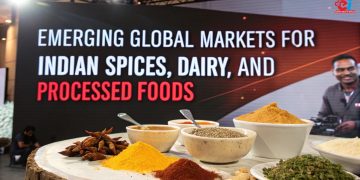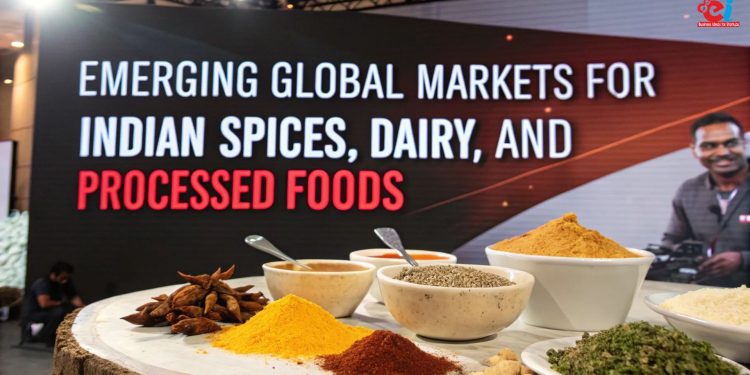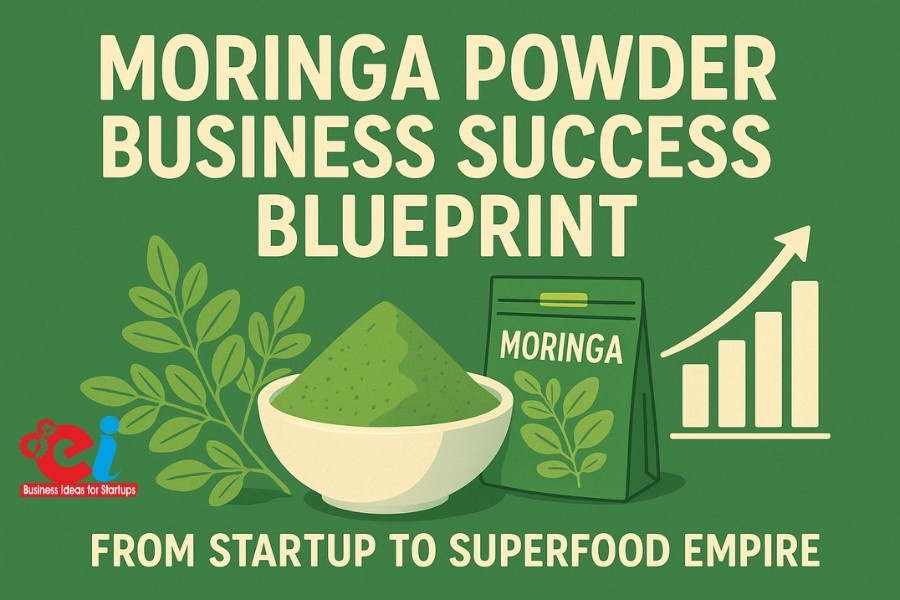India has always been recognized for its spice, dairy, and Processed Foods industries, which have experienced a surge in international demand. Entrepreneurs looking to invest in the processed foods industry can take advantage of India’s robust agricultural infrastructure along with the increasing global appetite for its products. This article assesses the global market opportunities for Indian spices, dairy, and processed foods, estimating market size and growth forecasts, analyzing demand drivers and key trends, and highlighting relevant government data alongside practical insights for startups, including the annual reports of The Ministry of Food Processing Industries.
Opportunities for India in Food Exports and Export Value Addition
The processed foods industry in India is pivotal to the economy, contributing approximately 7.7% of manufacturing GVA and 8.45% of agricultural GVA. A thriving processing industry aids in reducing wastage and increasing the income of farmers, garnering India valuable export markets. India’s agri-food exports have been growing consistently in the recent past. In the latest published data, The Ministry of Food Processing Industries (MoFPI) Annual Report 2022-23 states that India’s agri-food exports for 2023-24 were expected at 46.43 billion dollars, constituting approximately 11.7% of the country’s total exports. Of particular note is that the value-added exports which include spices, dairy products, and processed foods formed a large and increasing share of the export basket.
Related: 15 High Demand Food Products You Can Manufacture and Export from India
Trends in Food Exports
Within India’s Processed foods exports, spices remain one of the largest categories. For example, “coffee, tea, mate and spices,” which is mostly composed of spices, fetched $4.74 billion in 2023-24, compared to ~$3.20 billion in 2018-19. Dairy items (comprising milk, eggs, and honey) also showed some growth with exports increasing from ~$366 million during 2018-19 to $625 million in 2023-24. Similarly, processed foods products are increasing; for instance, the exports of prepared fruits and vegetables nearly doubled from $588 million to $1.16 billion during the same time frame.
Below is a chart showing these trends:
Indian processed foods: Exports of Spices, Dairy, and Processed Foods – FY2019 to FY2024. Although the value of spices dominates, the exports of processed foods are increasing rapidly, while dairy exports have started to grow after a slow start. Source: MoFPI Annual Report 2022-23
These numbers clearly illustrate that there is a growing opportunity available: foreign markets for Indian spices, dairy products, and processed foods are increasing. Business people stand to profit if they know which products are needed and where.
In the next sections, we analyze each segment – spices, dairy, and processed foods – to uncover potential markets, demand motivators, and forecast figures.
Indian Spices: A Growing Global Taste Sensation
India is often referred to as the “Spice Bowl of the World” for a reason: It is the biggest producer and exporter of spices in the world. India cultivates more than 60 varieties and supplies over 225 spice products. Indian spices are treasured for their diverse, delicious flavors.
Reaching India, Spices Are Globally Available And Marketed In More Than 200 Countries. In FY 2024-25 India’s Spice Export Revenue Was Estimated at USD 4.45 Billion. India Stays The Leading Spice Exporter. For India, Spice Exports Improved By Almost 97% In Value From 2013-14. Spices generate approximately 9 percent of India’s agricultural export income, showcasing their merit in the export economy.
Key Drivers for Global Demand
Spices as a Health Booster: The trend of health and wellness is gaining attention among people across the world. Items like turmeric, ginger, cumin, and pepper, which are considered anti-inflammatory or antioxidants, are being increasingly used in health foods and nutraceuticals. Spices are often touted for their health benefits in many countries, and this resonates with the shift towards natural products.
Culinary Appeal: Boost in demand for authentic spices has been witnessed due to the increasing popularity of international cuisines such as Indian, Thai, and Middle Eastern. The Indian diaspora settled in North America and Europe helps curry blends and spices maintain steady demand as they introduce these flavors to the local populace.
Clean and Green Labeling: The organic trend has grown rapidly in the last few years, and so has the rise in organic spices. The EU, US, and Japan markets are particularly keen on spices that are sourced organically and free from synthetic chemicals. This has created niche markets for Indian organic spice farmers.
Key Markets and Emerging Areas
Like other Indian products, Indian spices are well received by both the traditional and new markets. The top importers of Indian spices include China, the United States, the UAE, Bangladesh, and the UK, among others. Moreover, the top 10 countries are responsible for over sixty percent of spice earnings exported by India (as of FY 2024-25), and majorly include countries from Asia, North America, and Europe. China and the US are huge consumers as well (Chinese demand for chili and ginger; American demand for spice oils, curry powders, etc.). Significant buyers from the Middle East and South East Asia (Australia, Indonesia, Thailand, and Saudi Arabia) also boost demand.
As more regions begin to accept Indian spices, they are considered emerging markets. Exporting is expanding into unexplored areas, like Africa and South America as well as Eastern Europe which are being targeted as “untapped potential for Indian flavors”tastyandzesty.com. For example, many African nations have been importing greater quantities of spice blends and curry powders, which are slowly being adopted by local cuisines. The same is true for Latin America, which is seeing an increase of turmeric and ginger in the health food sectors. Eastern European countries are also an emerging frontier as globalisation continues. These are untapped areas beyond the well-known buyers which add to the growth potential.
Related: PMFME Scheme: A Game-Changer for Micro Food Enterprises in India
Forecast for Spices
The future of Indian spices in the international market looks very bright. Analysts suggest that India’s spice exports are expected to reach $10 billion by 2030 with a CAGR growth of 4.5% starting in 2024. This growth is expected due to the global shift towards healthy ingredients and more varieties of food. With India being the largest producer of spices, the country is in a prime position to take full advantage of this opportunity. Government support through the Spices Board and export subsidies also provide a boost to the industry.
On the other hand, Indian exporters need to improve on quality and compliance if they want to access more potential markets. There are strict quality regulations for importing countries, like the EU’s regulations on pesticide residues. Fortunately, India has managed to keep spice export rejections under 1% (Spices Board of India). However, these standards need to be upheld going forward. Also, climate change is a threat to the yields of spice crops (monsoons can impact pepper and cardamom). Meeting these challenges through innovation and sustainable practices will be essential to maintaining this growth rate.
Key Highlights
Indian spices have maintained a consistent international market, gaining popularity in the United States, the European Union, and emerging markets like Africa and Latin America. Entrepreneurs can take advantage of this opportunity by focusing on quality, organic farming, and targeted marketing in regions where the demand for Indian spices is rising. The sector’s future prospects remain “promising” given that Indian spices are associated with good taste and health in several countries.
Indian Dairy Products: Emerging Opportunities in Global Markets
India remains the largest global producer of milk, contributing to over 25% of the world’s milk production. Historically, India has not been a major player in dairy exports but this is changing slowly. Unlike the case for India’s approximately 230 million metric tons of milk production, available domestic dairy products are growing, which is a good sign for the global market. Indian companies are now shifting their focus toward exporting milk byproducts such as milk powder, ghee, paneer, and other dairy specialty products. This is good news for entrepreneurs in the dairy-processing industry.
Rising Global Demand and India’s Export Growth
India remains the largest global producer of milk, contributing to over 25% of the world’s milk production. Historically, India has not been a major player in dairy exports but this is changing slowly. Unlike the case for India’s approximately 230 million metric tons of milk production, available domestic dairy products are growing, which is a good sign for the global market. Indian companies are now shifting their focus toward exporting milk byproducts such as milk powder, ghee, paneer, and other dairy specialty products. This is good news for entrepreneurs in the dairy-processing industry.
Global Demand and Market Size
Dairy consumption across the world is increasing due to reasons such as an increase in population, a rise in income in developing nations, and an increase in interest towards protein-rich diets. The global market for dairy products is estimated to be approximately $517 billion in 2023 and is expected to be more than $700 billion by 2033. This is good news for new suppliers. While modest in relative terms, India also seems to be sparking some growth in its dairy exports.
Growth Trends and Export Data
Data from MoFPI indicates that India’s dairy exports surged from $352 million in 2021-22 to $612 million in 2022-23, primarily driven by exports of skimmed milk powder (SMP) during the Stagflation period. Exports were forecasted to stay high in 2023-24 at approximately $625 million. (For the sake of clarity, these figures include milk, honey, and eggs which are categorized under HS Code 4). So, other sources estimate the exports of pure dairy products (milk powders, butter, etc) to be $272 million in 2023-24. Even though this is a tiny fraction of India’s production, there is growth. To put things into perspective, India’s share on global dairy trade is a mere 0.25%. This indicates the vast untapped potential that exists, especially if even a small proportion of India’s milk production is turned into exportable dairy products.
From India’s dairy farms, skimmed milk powder (SMP), whole milk powder, butter, ghee, casein, and some cheeses are produced. India is also competitive in the global market for milk, exporting SMP to countries that have a shortage. There is also an increase in the demand for value-added dairy products such as flavored yogurts, traditional sweets, and A2 milk which are marketed as healthier than regular milk.
Major Markets for Indian Dairy Exports
In the past, India’s dairy exports were primarily sent to their neighboring countries and the Middle East region. South Asia serves as a natural market, where for instance, both Bangladesh and Bhutan import Indian dairy because of geographic convenience and taste preferences. These countries have also emerged as significant buyers. In 2023, UAE and Saudi Arabia were among the largest importers of Indian dairy products, accounting for almost 50% of India’s milk export volumes. These countries import Indian milk powder, butter, and ghee because of their limited local dairy production.
With these countries, United States and Singapore also seemed to appear on the list of top destinations for Indian dairy which likely import specialty items such as Indian ghee by the South Asian diaspora and casein for food industry use. Other markets that occasionally buy from India include Malaysia, Egypt and Nepal.
Challenges and Competition
It’s important to point out that India competes with New Zealand, the EU, and the US, who dominate the markets for milk powder and cheese. There are also regulatory challenges. For example, the EU and US have historically imposed Indian-import-restrictive health certifications for dairy goods. India’s dairy exports stand little chance in capturing market share as long as the country lacks quality standards and proper cold chain facilities.
Related food processing video
Prospects of Dairy Exports in India
Focus on the domestic market will strengthen with the expansion of the Indian dairy industry. Nevertheless, exports will improve from a lower threshold. As per the Government’s report, Indian dairy exports are showing a “promising” trend post-recovery after 2018. Analysts expect a sustained increase in the international demand for certain speciality Indian dairy products like organic dairy, lactose-free milk, specialty cheese, and ghee. For instance, the Indian diaspora and gourmet circles abroad are increasingly seeking organic A2 milk from Indian breeds and Indian milk-based sweets like gulab jamun and kheer.
One driver is the changing lifestyle globally: keto and high protein diets have led to increased consumption of butter and cheese which India can supplement. Moreover, the shift in consumer preference toward probiotics and functional foods opens the market for Indian fermented dairy products like yogurt and lassi if they are produced to global quality benchmarks.
Middle East and Africa should be the focus for growth because many of these countries have expanding populations but very little domestic milk production, which opens up a window for Indian exports. This is sometime referred to as the “India sized hole” in global dairy supply.
Conclusion and Takeaway for Dairy Sector
To conclude, despite quality certification, competition, cold chain logistics, and other challenges, there is room for Indian dairy exporters to grow into niche markets and neighboring areas. Investors looking to expand into dairy processing for exports should focus on high quality standards, strict hygiene, packaging, and shelf-life, supply-deficient or Indian community-dense target markets, and capitalize on India’s low-cost production for competitive pricing. With the right approach, India’s enormous dairy industry can significantly increase the country’s dairy export earnings in the foreseeable future. Demand for dairy products is steadily increasing around the globe. This puts India at a great advantage as it stands as the world’s largest producer of milk. There is now access to the Middle East, South Asia, and some parts of the West for Indian dairy exports. Meeting international standards for quality and compliance should be a priority for startups looking to break into the world markets. The recent rise in exports of dairy products (54% growth in just one year) combined with good policies and market research, indicates a big opportunity for the Indian dairy industry to expand its presence in the world.


























